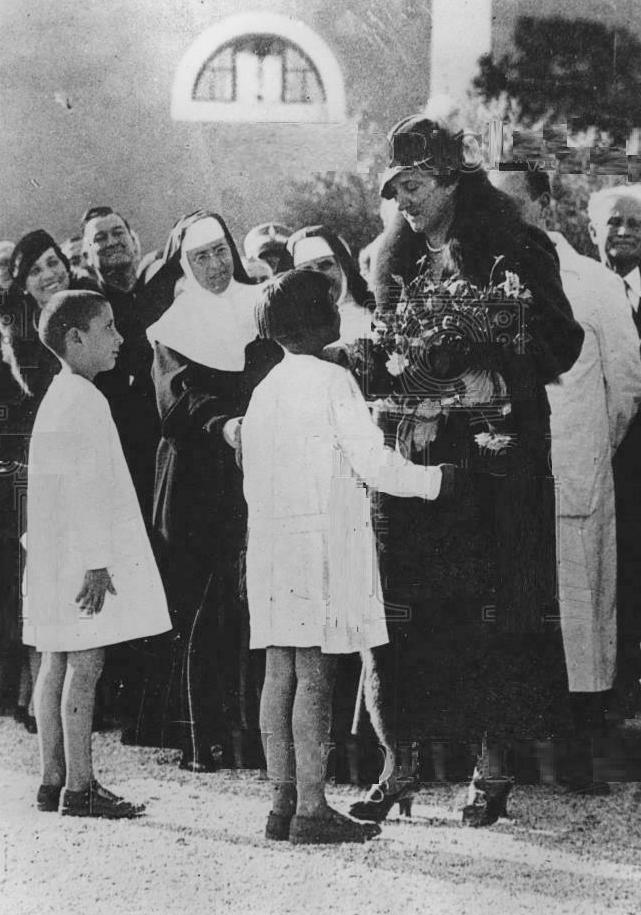
Sanitoria Country Trends: Italy

Figure 1.--After World War, the Italian Army closedits TB hospitals, with the sole exception of its sanatorium in Anzio. The Italian Red Cross disbanded its wartime units, directing its efforts to of new civilian sanatoria. The Red Cross established 'prevention centers' for the care of the children who had contracted TB. One of the best-known of these centers was the Fara Sabina center opened at the end of the War. it had a capacity of 100 beds. I t was temporarily closed and converted converted into a boarding school for the children. Here we see a hospital school in 1933. The press caption read, "A Boquet for a Queen: A little patient of the Hospital for Tubercular Children at Fara Sabina, Italy, presenting a floral offering to the Queen of Italy when she paid a visit to the Hospital recebtly to officially open new buildings there." The photograph is dated November 30, 1933. .
|
|
Doctors since Roman times have prescribed treating tuberculosis by moving to a warm temperate climate. As science developed, reaschers actually learned about the disease we begin to see sanatotia being opened (mid-19th century).
The earliest Italian efforts occurred at the turn of the 20th century. Italian and many other doctors were convinced that patients who had contracted pulmonary tuberculosis would benefit from a warm seaside climate and few countries had more potential sites than Italy with its extensive peinsukar seaside. One Itlaian academic, Biagio Castaldi. recommended the beneficial effects of mountain air and sunshine. He compiled dat showing a lower incidence of tuberculosis among people living in mountenous areas. Tis also gave some credence to the idea of a hereditary predisposition to TB. Several local committees (in Siena, Pisa, and Padua) were founded to deal with tuberculosis (1898). This lead to the founding of the Lega Italiana (Italian League) under the patronage of the King. This was the beginning of Italian state involvement in sanatoria. A pioneer in dedicated facilities to treatment tuberculosis was Edoardo Maragliano in Genoa (1896). This was followed by the first specialised hospital, with a capacity of 100 beds, in a non-mountainous area at Burdido (1900). Many doctors at the time subscribed to the idea of treating patients in the climatic environment to which they were accustomed. Facilities were opened throughout Italy (Bologna, Livorno, Rome, Turin and Venice). Mussolini's Fascist Government which seized power (1920s) took an interest in public health. They opened a large sanatorium for the treatment of working-class patients in Valtellina. Eugenio Morelli identified pine woods in Sortenna di Sondalo to be ideal for treating TB. World War I posed new challenges with men in the open in all clatic conditioms. the Italian Red Cross inaugurated the first military sanatorium at the'“Luigi Merello' maritime hospice in Bergeggi (SV) to treat soldiers affected by curable tuberculosis (December 1916). After the War, a new law ordered a 10-fold increase in funding for the construction of dispensaries and sanatoria (1919). The Provincial Anti-tuberculosis Committees were transformed into Consortiums of municipal and provincial authorities and anti-TB associations as part of an en effort to coordinate a national effort (1920s). Gradually the major effort to massist World War I veterans shifted to the civilian population. The Fascist Government ordered an Anti-tuberculosis Consortium be established in every province (1927).
HBC

Navigate the Historic Boys' Clothing Web Site:
[Return to Main sanitoria country page]
[Return to Main sanitoria page]
[Return to Main children's health institutions]
[Return to Main institutional page]
[Return to Main Canadian page]
[Introduction]
[Activities]
[Biographies]
[Chronology]
[Clothing styles]
[Countries]
[Bibliographies]
[Contributions]
[FAQs]
[Glossary]
[Images]
[Links]
[Registration]
[Tools]
[Boys' Clothing Home]
Created: 3:18 PM 10/15/2019
Last update: 3:18 PM 10/15/2019



